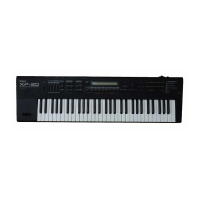56
Chapter 2. Playing
■ Playing Percussion Instruments
1. Press [RHYTHM] to call up the RHYTHM PLAY display.
2. Select a desired Rhythm Set.
3. Press a key on the keyboard to play a percussion
instrument.
The key (Note name) you press and its percussion
instrument name (Rhythm Tone name, the same as the Wave
it uses) will be displayed below the Rhythm Set name.
fig.2-15.e
You can also use the TONE SELECT buttons to select the
displayed key.
[TONE SELECT 1]: move to an octave lower key
[TONE SELECT 2]: move to the semitone below
[TONE SELECT 3]: move to the semitone above
[TONE SELECT 4]: move to an octave higher key
* When you want to play the percussive instrument sound
assigned to the B1 key, first push [-OCT] once, then press the
B2 key. Similarly, push [+OCT] once then press the C#6 or D6
key to play the percussive instrument sound assigned to the C#7
or D7 key. (On the XP-30, the leftmost white key is C2, and
rightmost white key is C7.)
For details, refer to “Transposing the Keyboard in Octave
Units (Octave Shift)” (p. 59).
Playing an Arpeggio
The XP-30’s Arpeggiator lets you produce an arpeggio
(broken chord) simply by playing a chord. In addition to
normal arpeggios, you can also accurately simulate guitar
cutting or strumming techniques depending on the
Arpeggiator settings. The Arpeggiator can in fact be used as
a handy automatic arranger.
By pressing [ARPEGGIO], the indicator lights and allows
playing arpeggios from the XP-30 keyboard.
* If you press [ARPEGGIO] to turn this function on when Single
Performance is selected, the current Part will play arpeggios.
When a Layer Performance is selected, an arpeggio will sound
for the Part specified by the Part parameter (SYSTEM/
ARPEGGIO/ARPEGGIO).
* The arpeggios played by the arpeggiator are also transmitted
from the MIDI OUT connector to external MIDI devices.
1. Make sure that the PLAY display of the sound source
mode (PERFORM, PATCH, RHYTHM, GM) is
displayed.
2. Press [ARPEGGIO] to turn the Arpeggiator on.
3. If you wish to change how the arpeggio is played, hold
down [ARPEGGIO] to access the ARP SELECT display,
move the cursor to the Style parameter, and change the
setting.
fig.2-16
* The selection you make here will also affect the Style parameter
(SYSTEM/ARPEGGIO/ARPEGGIO) settings.
There are 43 arpeggio styles available. For selection, refer to
the following guideline.
Playing an Arpeggio According to the Timing
Interval of a Note
1/4–1/32
Playing a Glissando
GLISSANDO
Playing a Bass Part
SYNTH BASS, SLAP BASS A, SLAP BASS B, WALK BASS
Playing a Guitar
RHYTHM GTR A, RHYTHM GTR B, RHYTHM GTR C,
RHYTHM GTR D, RHYTHM GTR E, 3FINGER GTR,
STRUMMING GTR
Playing a Keyboard Instrument
KBD COMPING A, KBD COMPING B
Playing a Waltz
KBD COMPING C, KBD COMPING D
Note name Rhythm Tone name

